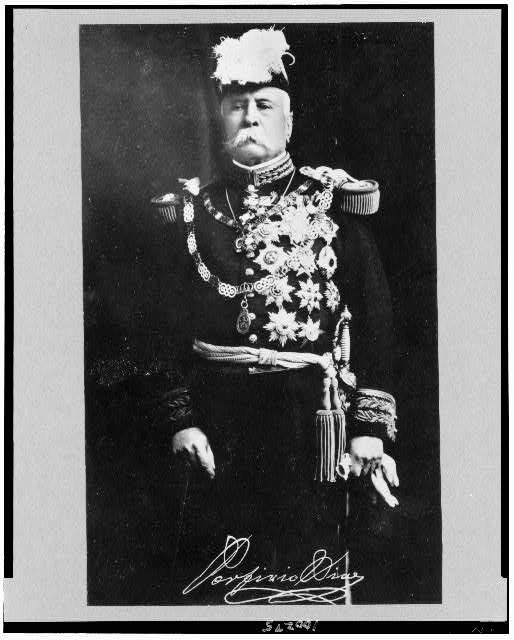 The Library of Congress >> Researchers The Library of Congress >> Researchers |
|
|
|
|
| Home >> Distant Neighbors | |
Versión en español
DISTANT NEIGHBORS: The U.S. and the Mexican RevolutionPresident Porfirio Díaz at 80Porfirio Díaz was president of Mexico longer than anyone else in its history. After his heroism in leading the troops against the French, he tried to gain the Presidency through a coup against President Benito Juárez in the abortive Revolt of La Noria in 1871. His Revolt of Tuxtepec in 1876 against President Sebastían Lerdo de Tejada prior to the 1876 elections was successful ultimately and he served as President from November 23, 1876 to November 30, 1880. During his term, he placated U.S. investors and reestablished relations with European powers. Manuel González was elected President for the next four-year term, while Díaz served as Minister of Development and Governor of Oaxaca. In 1884, Díaz returned to the office, not to relinquish it until 1911. During his presidency, Díaz and his advisers transformed Mexico by building railroads, schools, and installing overall infrastructure. They developed the beginnings of an oil industry and coaxed foreign money into mines and factories. However, his government did this at the expense of basic political freedoms, and economic control. Many critics were imprisoned or assassinated by the regime. As the decades went on, Díaz increasingly relied on voter fraud and the military to preserve him in office. After 1900, the arrangement started to deteriorate due to the president’s advanced age, and the lack of an agreed-upon successor, increasing nationalism both political and economic, and simply bad luck in part generated by economic depression in the United States. Finally, guerrilla wars in the south and combat victories in the north unseated Díaz, and on May 21, 1911 his advocates signed the Treaty of Ciudad Juárez with Francisco Madero. Díaz resigned the presidency on May 25 and left for Paris soon after where he died in 1915 and is buried in the famous Père Lachaise cemetery. Reproduction Number: LC-USZ62-100275 (b&w film copy neg.) El presidente Porfirio Díaz a los 80 añosPorfirio Díaz fue presidente de México por más tiempo que nadie. Después de su heroismo al mando de tropas contra los franceses, trató de asumir la presidencia a través de un golpe de estado contra el presidente Benito Juárez en la fallida revuelta de La Noria en 1871. Su revuelta de Tuxtepec en 1876 contra el presidente Sebastián Lerdo de Tejada tuvo éxito y ejerció como presidente del 23 de noviembre de 1876 al 30 de noviembre de 1880. Durante este periodo, calmó a los inversores estadounidenses y restableció relaciones con las potencias europeas. Manuel González fue elegido presidente para los próximos cuatro años, mientras que Díaz ejerció de Ministro de Desarrollo y gobernador de Oaxaca. En 1884, Díaz regresó a la presidencia para no abandonarla hasta 1911. Durante su presidencia, Díaz y sus consejeros transformaron México con la construcción de ferrocarriles, escuelas y creando una base de infraestructuras para el país. Desarrollaron los principios de una industria petrolera y persuadieron a capital extranjero para invertir en minas y factorías. Sin embargo, su gobierno hizo todo esto a expensas de derechos politicos básicos y control económico. Muchos críticos del régimen fueron encarcelados o asesinados. A medida que las décadas pasaban, Díaz se apoyaba cada vez más en el fraude político y en el ejército para mantenerse en el poder. Después de 1900, este arreglo empezó a deteriorarse debido a la avanzada edad del presidente y a la falta de consenso sobre un sucesor, el aumento del nacionalismo, tanto politico, como económico, y simplemente mala suerte, generada en parte por la recesión económica en los Estados Unidos. Finalmente, guerras de guerrilla en el sur y en el norte derrocaron a Díaz y el 21 de mayo de 1911, sus seguidores firmaron el Tratado de Ciudad Juárez con Francisco Madero. Díaz dimitió el 25 de mayo y poco después salió para París, donde murió en 1915 y donde sigue enterrado. |
| |
||||
|
|
|
|||
| Home >> Distant Neighbors | ||||
| ||||
